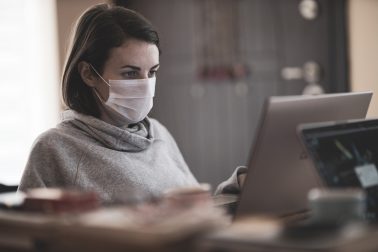Creating a COVID-secure workplace

Government guidance still states that if employees can work from home, they should still continue to do so. However for those who cannot work from home, the Government is encouraging employers to welcome back their workforce, providing the workplace is COVID-secure and safe enough to do so.
Here are a few tips on how to get your workplace COVID-secure, so you can reassure employees that they will remain safe while at work.
Coming to work and leaving work
Employers should look to encourage social distancing wherever possible. Although offices, warehouses and factories were never designed with social distancing in mind, there are several ways you can control people flow.
- Use floor markings to reinforce social distancing rules and introduce one-way flow at entry and exit points. Try to create one entrance and a separate exit to reduce the risk of employees passing each other and to ease congestion points in the building. Communicate these changes clearly with signage.
- Provide handwashing facilities, or hand sanitiser where not possible, at entry and exit points.
- Define process alternatives for entry/exit points where appropriate, for example, deactivating turnstiles requiring pass checks in favour of showing a pass to security personnel at a distance.
- Offer more storage for workers for clothes and bags. Try to keep the office space as clear of clutter as possible to reduce the number of items that could become cross contaminated.
- Create additional parking or facilities such as bike racks to help people walk, run, or cycle to work where possible.
- Limit passengers in corporate vehicles, for example, work minibuses. This could include leaving seats empty and using signage to communicate which seats are not in use.
- Safety barriers and queue control barriers can be useful in managing people flow during shift changes and at entry and exit points.
Hygiene: handwashing, sanitation facilities and toilets
Under the Health and Safety at Work Act 1974, employers have a duty of care to protect their employees. As part of this requirement, workplaces need to be maintained, clean and hygienic – now more so than ever.
- Use signs and posters to build awareness of good hand washing techniques, the need to increase hand washing frequency, avoid touching your face and to cough or sneeze into a tissue which is binned safely, or into your arm if a tissue is not available.
- Provide regular reminders and signage to maintain personal hygiene standards.
- Provide hand sanitiser in multiple locations in addition to washrooms.
- Set clear use and cleaning guidance for toilets to ensure they are kept clean and social distancing is achieved as much as possible.
- Increase cleaning for busy areas.
- Provide more waste facilities and more frequent rubbish collection. Touch-free waste bins will help prevent cross contamination by reducing unnecessary touchpoints.
- Where possible, provide paper towels as an alternative to hand dryers in handwashing facilities.
Moving around buildings and worksites
It is vital that if employers are asking employees to return to work, that the workplace is COVID-secure. We can help reduce the spread of infection by maintaining hygiene and social distancing standards.
- Restrict access between different areas of a building or site by using safety barriers or tape to demarcate specific areas.
- Reduce maximum occupancy for lifts, providing hand sanitiser for the operation of lifts and encouraging use of stairs wherever possible.
- Use floor tape or paint to mark areas to help workers keep to a two-metre distance.
- Clean and sanitise workstations between different occupants including shared equipment, such as printers.
- Increase the number of waste bins so employees can dispose of waste quickly.
- Reduce the number of touchpoints and introduce pedal operated equipment where possible. Use fire door holders to legally hold open doors and reduce the need for employees to touch door handles.
- Use screens or barriers to separate people from each other. Clear screens can be used on desks or workstations and will provide a sneeze screen between employees.
Getting the workforce back will require careful planning and minor adjustments for most businesses, but there are many straightforward and cost-effective ways to create a COVID-secure workplace.
Take a look at our dedicated page on Social Distancing in the Workplace — packed with useful information and guidance for businesses.
Follow our step-by-step guide to Coronavirus Infection Control to help your business operate safely.
